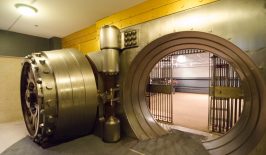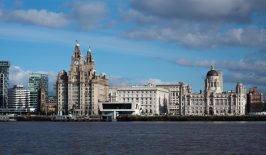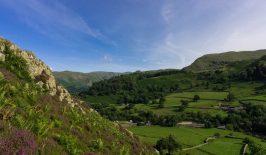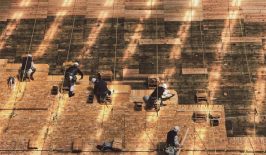A forest that manages itself with the help of distributed systems, chops down its own trees and then sells the wood? How could that ever work? That’s what the interdisciplinary project terra1, funded by the BMBF (Germany’s Federal Ministry for Education and Research) is trying to find out. The project is being coordinated by the Forschungszentrum Informatik (FZI) with Berlin’s University of the Arts (UdK), the Wuppertal Institute for Climate, Environment and Energy, inter3 (Institute for Resource Management) and the company Zebralog also involved as research partners.
Terra1 emerged from the UdK project terra0, which was set up by Paul Seidler, Paul Kolling and Max Hampshire. The three bring expertise from various different fields – from graphic design, computing and construction, to media art and philosophy. And other people have also been getting on board as needed, when they have relevant useful specialisms – for example knowledge about sustainability and development policy. The three developers are currently carrying out an experimental project to investigate the tokenisation and verification of natural raw materials.
We talked to Paul Seidler about his research projects, about the potential of the blockchain for sustainable development – and why it can’t be a blueprint for solving social problems.
Paul, your research project has the catchy title “Bioeconomics 4.0 – How can forests manage themselves?” What exactly is it that you’re researching?
Originally we were working with Bitcoin and Blockchain and in that context we became very interested in the development of Smart Contracts. We wanted to know how distributed systems could enable autonomous programs and we started thinking about natural resource management systems in that context. We believe there’s something lacking there. Our project is looking at the question: What happens if you hand over economic autonomy to a program that acts in the interest of a natural system? The blockchain is a very good tool for that because it can be used to present this type of autonomous action in a transparent way.
Blockchain technology is criticised for consuming huge amounts of energy. How is that compatible with sustainability? Can you challenge that accusation?
Yes, and it’s relatively easy. Proof-of-Work (PoW), the consensus algorithm used by Bitcoin, but also by many other crypto currencies in the mining process, is indeed very computationally intensive and consumes a lot of energy. But that’s no longer in keeping with the times – many more modern platforms now use other solutions. For example, the Ethereum network, which we also use, is currently switching to Proof-of-Stake (PoS), a consensus algorithm where no mining is needed at all.
Back to the forest – where does that come into your project?
Well, basically forests have a symbolic quality which makes them ideal for creating a narrative – for explaining things better to people. We haven’t finished developing the system yet, we’re right in the middle of the process. But to illustrate what we are currently working on, we like to use the example of a forest that chops itself down.
And how is a forest able to manage itself? How does it work?
There is a decentralised program that’s stored in the blockchain – the Smart Contract. You also need some kind of sensor, e.g. satellite images. But that could also be the forester who goes into the forest and collects the data. This data is then transferred to Oracle, which is technically nothing more than a program that processes data and feeds it into the Smart Contract. The Smart Contract then makes very simple decisions. For example: There are 100 trees, of which X trees have the age Y. The Smart Contract says: From that age on, 30 per cent must be felled – and then issues the corresponding licenses for felling. Those are basically tokens that users can buy. Whoever buys them then has the right to go into the forest and cut down that tree. There’s not much human decision making necessary anymore, because all of this takes place between the Oracle and the Smart Contract.
Okay, and how does it look in reality?
We actually had a piece of forest in Brandenburg for a while where we were able to test the whole thing. We got people on board who are really familiar with forestry, we documented trees, looked at algorithms and even wrote them ourselves, e.g. algorithms to recognise trees on satellite images and to automate certain processes.
How far did you get with your self-organised forest?
Unfortunately, satellite images aren’t worthwhile for such a small piece of forest, it’s far too expensive. Also, it’s not a very decentralised way of verification, because you have a central source – if that source fails, the whole system is broken. Now we’re researching alternatives and looking at how you can do that on a relatively small level.
You mean the big shelf behind us, with the plants?
Exactly. That’s why we built this test case with 100 plants. In our experiment, a camera regularly takes a photo of the whole shelf and an analysis is made for each plant – how big the plant is, how it grows, the colour spectrum, etc. And then we put all of that data into individual tokens. So by the end, for the whole case, there will be 100 individual tokens. Here we want to investigate how tokens behave if you connect them to real objects and constantly verify them. People can see this whole shelf via a web interface and buy, sell and trade the individual plants. This basically gives us a micromarket of tokens tied to individual plants. Our first concern now is to build a functioning system to show what the technology can do – to show that something like this works, that it has a real world connection.
From your project-related perspective, where do you see the potential of the blockchain for sustainable development?
With the blockchain, the middleman can be replaced, meaning that direct interaction can take place – whether that means for communicating or negotiating prices. What I find particularly interesting, however, is that the blockchain and distributed systems are shaking up many concepts, and re-examining them: What is an entity and how can it be negotiated? What is a company, how can it be represented? What is a natural person, what is a legal entity?
What does this have to do with sustainable development? Can you give an example?
There is a river in New Zealand, the Whanganui River, which was recognised last year as a legal entity. Because the management and protection of this river had not been clarified, indigenous communities had complained. Now the rights of the river are represented by two trustees. And the model seems to be getting more interesting – there are now three rivers that have been declared legal entities.
I see. So that could also be applied to nature reserves and say: This entity has rights that must be protected.
Exactly, and that raises the question of how those rights are administered and represented. Our system could make a lot of sense in that context. It could create new agency and resources could be managed more efficiently and more sustainably. We believe that it could be applied to forestry and nature conservation – i.e. the conservation and financing of certain ecosystems. But we also have to ask questions: Where do the ownership and power relations lie? Who controls what?
In the forest example you gave, I asked myself: If an algorithm determines when a certain number of trees will be felled, is that actually in the best interest of the forest?
Yes, you have to ask: who actually sets up the criteria for the algorithm? Technologies always implement some form of policy or ideology – and that’s something we need to talk about and analyse more closely. We are always happy when people tell us: “Wait a minute, in your case, it’s not actually the forest that’s managing itself.” And we say: “Exactly! It’s a program that somebody has written.”
And then there is always the question of who actually provides the infrastructure for the blockchain. That can lead to conflicts of interest.
That’s true, but it’s a governance issue more than anything. It’s not a technological question – instead we’re talking about social issues and distribution issues. Can technology solve something like that? I don’t know.
And yet people often act as if “the blockchain” is the solution to all problems.
Well, technology cannot solve all social problems per se, but it can be a lever. And it’s also a tool for discussing social problems and initiating discourses. That’s also one of the goals of our project: to initiate questions. What does a self-governing forest do? What is better about this system when compared to others? What is worse? The results of conversations like this can then also be transferred to other automation processes.
What’s next for your project?
Our short-term goal is to get this thing up and running. And of course we want to get funding to be able to develop our technology. Ultimately, we are always somewhere between technology developer and think tank: we want to shape the discourse and above all think about this whole issue on a more global level.
This article is a translation by Marisa Pettit of an original article which first appeared on RESET’s German-language website.





